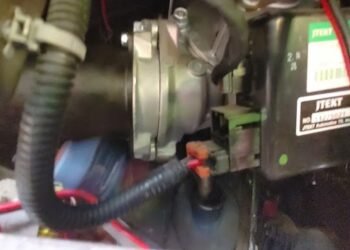Coolant loss in a car is common. But how much is normal?
Understanding coolant levels is crucial for your car’s health. A small amount of coolant loss over time is typical. It can happen due to evaporation or minor leaks. However, significant loss might indicate a problem. It’s essential to monitor your coolant levels regularly.
This helps in preventing engine overheating. In this post, we will explore what constitutes normal coolant loss. We will also discuss signs of potential issues. Stay with us to learn more about maintaining your car’s cooling system. This knowledge can save you from costly repairs. Let’s dive in and keep your engine running smoothly.

Credit: www.reddit.com
Introduction To Coolant Loss
Coolant loss can cause serious problems for your vehicle. Understanding how much coolant loss is normal is crucial. This section will introduce you to the concept of coolant loss. It will also explain the importance of coolant in engines. Let’s dive in.
What Is Coolant?
Coolant is a fluid used in vehicles. It helps regulate the engine’s temperature. It is also known as antifreeze. Coolant prevents the engine from overheating. It also stops the engine from freezing in cold weather. Coolant is usually a mixture of water and chemicals. These chemicals help transfer heat away from the engine.
Importance Of Coolant In Engines
Coolant plays a vital role in engine performance. Without it, the engine can overheat. Overheating can cause significant damage. The coolant absorbs heat from the engine. Then, it dissipates the heat through the radiator. This process keeps the engine at an optimal temperature.
Coolant also prevents corrosion inside the engine. The chemicals in coolant protect engine parts. This ensures a longer engine life. Regular checks on coolant levels are essential. Low levels can signal a problem. Early detection can save you from costly repairs.
Normal Coolant Loss
Understanding normal coolant loss is crucial for maintaining your vehicle’s health. Coolant, or antifreeze, keeps the engine from overheating. It’s normal to lose a small amount of coolant over time. But how much is too much? Let’s explore the expected coolant consumption and the factors influencing coolant loss.
Expected Coolant Consumption
Most vehicles lose a small amount of coolant naturally. This happens through evaporation and tiny leaks. On average, you might lose a few ounces every few months. If you check your coolant levels regularly, you should notice slight drops over time.
Modern cars have sealed cooling systems. They minimize coolant loss. Older cars might lose more coolant. A quart every few months can be normal for them. Always follow the car manufacturer’s guidelines.
Factors Influencing Coolant Loss
Several factors can affect how much coolant your car loses. Driving habits play a role. Hard driving or heavy towing can increase coolant loss. Temperature impacts coolant levels too. Hot climates might cause more evaporation.
Leaks are another common factor. Even tiny leaks can cause noticeable coolant loss over time. Check hoses, the radiator, and the water pump for leaks. Regular maintenance helps spot and fix these issues early.
Engine condition also matters. Older engines might burn coolant due to worn-out parts. Head gasket issues can lead to coolant loss too. It’s important to get your engine checked if you notice a significant drop in coolant levels.
Signs Of Abnormal Coolant Loss
Noticing a drop in your car’s coolant level can be concerning. Understanding the signs of abnormal coolant loss can help you act quickly. This ensures your vehicle runs smoothly.
Common Symptoms
One common symptom is frequent overheating. If your car’s engine gets too hot often, there might be a coolant issue. Another symptom is a sweet smell inside or around your car. This could mean a coolant leak. You might also see steam from the hood. This is a clear sign of coolant trouble.
Visual Indicators
Checking the ground under your car can reveal coolant leaks. Look for green, orange, or pink fluid spots. These spots signal a coolant leak. Also, inspect the coolant reservoir. If the coolant level is low, it might be leaking. Another indicator is white smoke from the exhaust. This could point to coolant entering the engine.
Causes Of Coolant Leaks
Coolant leaks can be a common issue in vehicles. They can cause overheating and engine damage. Understanding the causes of coolant leaks helps maintain your car’s health. Let’s explore some of the main causes of coolant leaks.
External Leaks
External leaks are easy to spot. They often leave puddles of coolant under the car. These leaks occur due to:
- Damaged hoses: Hoses can crack or become loose over time.
- Faulty radiator: The radiator can develop rust or cracks.
- Water pump issues: The water pump may wear out and leak.
- Loose clamps: Clamps holding the hoses can loosen.
Regular inspection of these components can prevent leaks.
Internal Leaks
Internal leaks are harder to detect. These leaks allow coolant to mix with engine oil or enter the combustion chamber. Causes of internal leaks include:
- Blown head gasket: This can allow coolant to enter the engine.
- Cracked engine block: Severe overheating can crack the block.
- Damaged cylinder head: Overheating can also damage the cylinder head.
Signs of internal leaks include white smoke from the exhaust and milky oil.
Both internal and external leaks need immediate attention. Ignoring them can lead to costly repairs.
Diagnosing Coolant Loss
Diagnosing coolant loss is essential for maintaining your car’s health. Small leaks can lead to big problems if left unchecked. Understanding the causes helps prevent overheating and engine damage. This section explains how to diagnose coolant loss effectively.
Inspection Techniques
Start by visually inspecting the engine bay. Look for wet spots under the car. Check around the radiator and hoses. Any signs of green, pink, or orange fluid indicate a leak. Examine the radiator cap for cracks. Inspect the coolant reservoir for proper levels. Low levels may signal a problem.
Diagnostic Tools
Use a pressure tester to check the cooling system. Attach the tester to the radiator cap. Pump the tester to the recommended pressure. Watch for leaks as the system holds pressure. A drop in pressure indicates a leak. A UV dye can help locate small leaks. Add the dye to the coolant. Use a UV light to find glowing spots. This method is effective for finding hidden leaks.

Credit: www.reddit.com
Preventing Coolant Loss
Preventing coolant loss is essential to keep your vehicle running smoothly. Regular checks and maintenance can help avoid expensive repairs. Let’s explore some effective ways to prevent coolant loss.
Regular Maintenance
Regular maintenance is crucial for preventing coolant loss. Check your coolant levels at least once a month. Look for signs of leaks under your car. A puddle of bright green, orange, or pink fluid can indicate a leak. Ensure all hoses and connections are tight. Replace any worn-out parts promptly. Regular maintenance can save you from unexpected breakdowns.
Using Quality Coolant
Using quality coolant helps in preventing coolant loss. Cheap coolants can evaporate quickly. They can also damage your engine. Always choose a coolant recommended by your vehicle’s manufacturer. Quality coolant maintains the right temperature. It prevents your engine from overheating. This reduces the risk of coolant loss significantly.
When To Seek Professional Help
Identifying when to seek professional help with coolant loss is crucial for your vehicle’s health. While some coolant loss is normal, persistent issues may require expert attention. Understanding the signs can save you from costly repairs.
Persistent Issues
Repeatedly topping up coolant is a red flag. If the coolant level drops quickly, there could be a leak. This isn’t something to ignore. Consistent loss suggests a deeper problem. It may be an internal leak or a failing gasket. A professional can diagnose these issues accurately.
Complex Repairs
Some repairs demand specialized tools and knowledge. Fixing a radiator or replacing a water pump isn’t a DIY job for most. These parts are vital for your engine’s cooling system. Incorrectly handling them can lead to bigger problems. Trusting a professional ensures the job gets done right.
Expert Tips On Coolant Management
Effective coolant management ensures your vehicle runs smoothly. Maintaining the right levels of coolant prevents engine overheating and damage. Let’s dive into some expert tips to manage your coolant effectively.
Best Practices
Following best practices helps maintain your coolant system. These are essential tips:
- Regularly check coolant levels. Use the indicator lines on the reservoir.
- Top off coolant with the right mixture. Use a 50/50 blend of coolant and water.
- Inspect hoses and connections. Look for signs of wear or leaks.
- Flush the system as per manufacturer’s recommendation. Usually, every 30,000 miles.
- Use the right type of coolant. Refer to your vehicle’s manual.
Common Mistakes To Avoid
Avoiding common mistakes can save your engine from severe damage. Here are some common pitfalls:
- Using plain water. It lacks the necessary properties to protect the engine.
- Ignoring leaks. Small leaks can lead to bigger problems.
- Overfilling the reservoir. It can cause pressure buildup and damage the system.
- Neglecting the coolant change schedule. Old coolant loses its effectiveness.
- Mixing different types of coolant. It can create harmful reactions.

Credit: www.reddit.com
Frequently Asked Questions
How Much Coolant Loss Is Normal?
Coolant loss of a few ounces over several months can be normal.
Why Is My Car Losing Coolant?
Small leaks, evaporation, or engine issues can cause coolant loss.
How Do I Check For Coolant Leaks?
Look for puddles under the car or inspect hoses and connections.
Can Low Coolant Damage My Engine?
Yes, low coolant can cause overheating and engine damage.
How Often Should I Check My Coolant Level?
Check your coolant level monthly or before long trips.
Conclusion
Regular coolant checks ensure your engine stays healthy. A small coolant loss is normal, about a few ounces monthly. Large losses need attention. Always keep an eye on coolant levels. Address leaks promptly. This prevents bigger issues later. Seek professional help if unsure.
A well-maintained coolant system means a smooth-running vehicle. Your car will thank you. Stay safe and drive confidently.

















